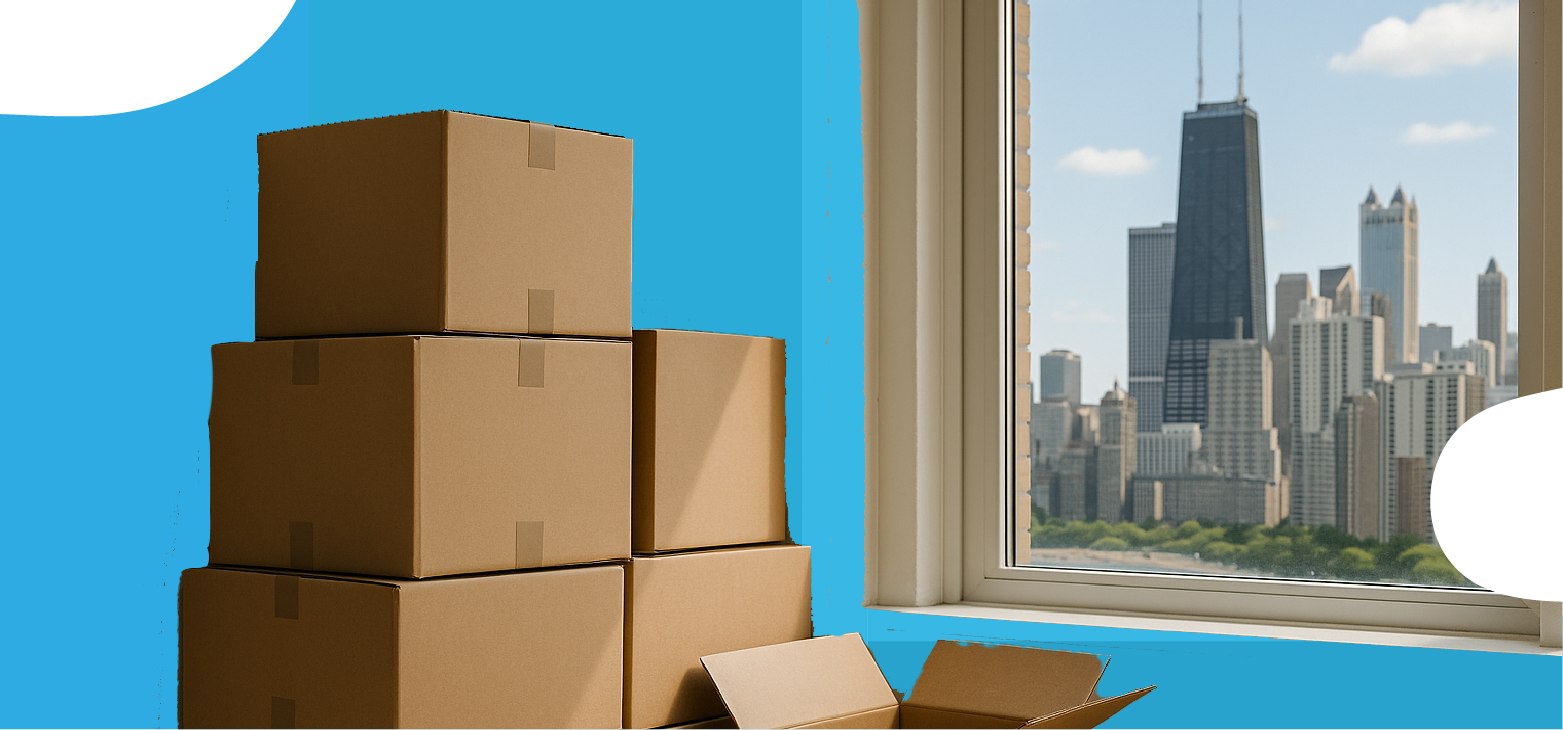Is Chicago a Good Place to Live? Pros, Cons & Advice From Experts
by Jenna Mendez
22.9 min read

Are you thinking about moving and wondering if Chicago is a good place to live? This guide is for you! From its stunning skyline and world-class food scene to its rich cultural neighborhoods and vibrant job market, Chicago has a magnetic pull for people from all walks of life.
Whether you're moving for a new job, chasing a fresh beginning, or just intrigued by what it's like to live in Chicago, this guide shares real insights straight from Illinois experts from Santanna Energy Services who know the city inside and out – including me, Jenna. Let's explore what makes Chicago tick and whether it's the right place for you to call home. Keep reading to get a full, unfiltered look at life in Chicago.
Key Points of This Article:
- Chicago overall is a great place to live!
- Pros of living in Chicago include outstanding food, vibrant sports culture, dynamic nightlife, career opportunities, and diversity.
- Cons of living in Chicago include harsh winters, higher crime rates, traffic congestion, high housing costs, and expensive parking.
- Cost of living is higher than the national average, with housing being the largest expense and fluctuating energy bills.
- Chicago offers a blend of big-city amenities and Midwestern charm, providing a high quality of life with cultural richness and diverse neighborhoods.
- Best time to move is late spring to early fall, prepare for winter, and use apps for parking.
An Overview of Living in Chicago
If you're thinking about calling Chicago home, it helps to get a feel for its unique roots and modern-day makeup. Rooting in Chicago myself, I'll give you a little history of this great city.
The name "Chicago" actually comes from a Native American word—used by the Illinois and Miami peoples—that originally referred to wild leeks growing near the river, though it also had a less flattering meaning: striped skunk. Over time, the city picked up the nickname "The Windy City," which isn't just about the breezes off Lake Michigan—it's also a nod to the city's famously bold political culture. You'll also hear it called the "Second City," a name that stuck after the Great Chicago Fire and its remarkable rebuild.
Today, Chicago is a vibrant cultural hub where people from all backgrounds come together. It's a true melting pot, with diverse communities adding to the city's energy and character.
Unfortunately, living in Chicago is expensive, with a cost of living that's approximately 15% higher than the national average. Expenses such as housing, transportation, and utilities vary by neighborhood and local job market. The city's demographics reflect its diversity, with about 53% of residents identifying as white, followed by nearly 21% who identify as Hispanic, with various cultural groups concentrated in different parts of the city.
Chicago's economy has its ups and downs. As of early 2025, the unemployment rate nudged slightly up to 5.3%, although job growth has also been steady, with over 18,000 new non-farm jobs added year-over-year. All in all, living in Chicago means balancing opportunity, culture, and costs in one of the country's most iconic cities.
And now for my favorite part: when it's time to unwind, few cities deliver like Chicago. From award-winning restaurants and legendary deep-dish pizza to a nightlife scene that never sleeps, the city makes every weekend feel like an adventure.
Add in world-class sports teams—from cheering on the White Sox at Rate Field (sorry Cubs fans) to tailgating with Bears fans—and you've got a lifestyle that's as spirited as it is satisfying. Whether you're raising a family or living solo, Chicago offers something for everyone at every hour of the day.
Is Chicago a Good Place to Live? Here's What to Know
Take it from a local who was born and raised here: yes, Chicago is absolutely a great place to live, especially if you're seeking a blend of big-city amenities and Midwestern charm.
Chicago offers an impressive quality of life, a vibrant culture, and a globally significant economy, ranking among the top financial centers worldwide. I feel Chicago delivers that "big city feeling" without the crowds or higher-than-average price tags of its East and West Coast counterparts. Plus, it's friendly, community-focused vibe helps newcomers feel at home.
Pros of Living in Chicago
Now that you've had the chance to learn about this great city, are you looking for a breakdown of the pros of living in Chicago? Take it from a native Chicagoan; here's what makes Chicago a great place to call home:
The Food Is Outstanding
From deep-dish pizza and Chicago-style hot dogs to globally inspired eats, the city earned national acclaim, boasting multiple James Beard-winning restaurants like Oriole, Kumiko, and Lem's Bar‑B‑Q in 2025. In my experience, Chicago has an unmatched mix of high-end and neighborhood flavors, making every meal feel like an adventure.
Even when you're tired of the same old city food, the surrounding Chicagoland suburbs have many more options to offer. If you're looking for some awesome pizza, check out Joe's Italian Villa in Palos Hills. For tacos, you'll want to visit Atotonilco in both Joliet and Chicago.
Sports Fans Are Excellent
Chicagoans live and breathe their teams—from the Cubs at Wrigley to the Bulls and Blackhawks downtown. And not many cities can say they have two baseball teams, a basketball team, a football team, a hockey team, AND a soccer team, all with national and world championships.
While most Chicago teams have been in a bit of a slump over the last few seasons, fan loyalty remains high, turning games into community events almost year-round, making Chicago a great place to live.
Nightlife Is Popping
With hundreds of music venues, rooftop lounges, dive bars, and late-night eats, Chicago's nightlife is diverse and inclusive. Whether you want live jazz (The Green Mill is a personal favorite), speakeasies, or casual downtown spots, there's always a place for your vibe. And if the nighttime scene isn't your thing, there's plenty of daytime entertainment like concerts in Millennium Park, beach days on Lakeshore, and much more to round out your day.
Career Opportunities Abound
If you're looking for new career opportunities, Chicago's got you. Home to over 4,817,600 non-farm employees as of November 2024 and 35 Fortune 500 headquarters, Chicago offers strong job growth in fields like finance, manufacturing, life sciences, and professional services.
Straight out of college, many of my friends found opportunities to work in the corporate branches of McDonald's, Google, and Grubhub, among others. In my experience, the city of Chicago is always hiring and seeking new talent.
So Much Diversity
Chicago ranks 8th among major U.S. cities for culinary diversity, thanks to its immigrant-rich heritage. With over 100 languages spoken and communities from more than 150 countries, the city is a living testament to global influence.
From authentic dim sum in Chinatown to bold murals and traditional tamales in Pilsen, the aromas of Greektown's Mediterranean dishes (Greek Islands is a must-visit) and the Scandinavian charm of Andersonville reflect more than just food—they tell the story of generations.
Fun for the Whole Family
Between free neighborhood festivals, educational museums, Lake Michigan beaches, and children's events, Chicago genuinely offers fun for all ages, year-round and often at little to no cost.
There's a reason Chicago consistently ranks among the top U.S. cities for families. But don't just take our word for it—hear from Illinois local and Santanna Help Desk Technician Ty Cordoba, who's lived in the Chicago area since he was 11. A longtime resident and proud Chicagoan, Ty shares, "Chicago has an almost unlimited amount of things to do."
When asked, "What are your recommendations for things to do with family in Chicago?" he answered. "My favorite family event would have to be the museums. I love the Adler Planetarium as well as the Museum of Science and Industry." Both museums are widely regarded as highly interactive and educational. He also states, "As a car enthusiast, one of my favorites is the Volo Auto Museum. They have practically every cool and popular car up for display from movies (like Back to the Future and Ghostbusters)!"
Spoken like a true local, Ty also stressed not to dismiss the entertainment within the Chicagoland area and suburbs, saying, "The reach and integration of Chicago is so vast that the cities around it are called Chicagoland. I don't believe any other city has anything like that."
Even More to Do in the Suburbs
Beyond the city limits, vibrant suburban communities offer farmers' markets, parks, and family attractions. These areas balance the perks of suburban life with easy access to city amenities and transit.
If you're visiting the suburbs, I highly recommend a trip to the Brookfield Zoo! With a 90-year-long history, this Chicago zoo is committed to conservation. With interactive exhibits like the Gorilla Falls VR experience, the bird feeding experience, the Hamil Family Play Zoo, and dolphin shows, this zoo is for families of all ages.
If you're a nature lover, I think you'll love visiting the Morton Arboretum in Lisle, IL, and Cantigny Park in Wheaton, IL, too. The Morton Arboretum spans over 1,700 acres and features more than 222,000 live plants, scenic walking trails, and immersive seasonal events like the Illumination light show in winter. Just a short drive away, Cantigny Park offers beautifully landscaped gardens, wooded trails, and the engaging First Division Museum—perfect for both a peaceful stroll and an educational afternoon.
Of course, this is just the tip of the iceberg of what waits in the suburbs of Chicago.
Transportation Is Easy
Chicago's CTA system (trains & buses) runs 24/7; Metra and South Shore trains extend their reach to suburbs and nearby cities if you don't have access to a car. Almost a third of Chicagoans don't own cars, but thanks to its walkability and transit access, it's really not a problem.
If you do own a motor vehicle, luckily, Chicago is connected to some of the most major highways in Illinois. As long as you don't get caught in the big city traffic, driving in and out of the city is actually a breeze, and you can reach suburban cities in 30 minutes or less.
Lots of Choices for Where to Live
Chicago is home to more than 200 distinct neighborhoods, each with its flavor—from high-rise downtown and riverwalk condos to leafy bungalows in suburban-feel enclaves—so homeowners can find exactly the environment they want. Whether you're looking for the bustling energy of River North, the historic charm of Lincoln Square, or the lakeside serenity of Rogers Park, there's a community that fits nearly every lifestyle and budget.
Trust us, some of the best areas to live in are already in the city itself! With access to parks, public transit, highly rated schools, and neighborhood-specific gems like local farmers' markets or corner cafes, Chicago offers a blend of urban convenience and residential comfort that's hard to beat, especially for Midwestern families and professionals alike.
At this point, if city living isn't your jam, try the suburbs! We have a complete list of the best places to live in the Chicago suburbs here.
Cons of Living in Chicago
Like any place to live, Chicago has its cons. Coming from a local, here are my recommendations on things to watch out for when considering a move to Chicago:
Winter Can Be Harsh
Chicago winters typically stretch over three months (and sometimes more), with average highs below 43°F from early December to March and brutally cold nights in January and February. Heating bills surge, and families may spend over $1,000 just to stay warm.
I've experienced many winters where temperatures drop to well below freezing, and the winds sting your face and skin. In true Midwest fashion, I believe the weather in Chicago wouldn't be so bad if it weren't for the wind!
When asked about Chicago winters, Ty says, "My genuine advice is to check the weather often, as things tend to change drastically from morning to mid-day or overnight. Also, stock up on thermals, hats, gloves, and heavy coats. Layers are your friend in the winter. Just be mindful that if you're going to be inside of a building, those layers could come back to bite you if the building manager keeps it extra warm."
Crime Can Happen
Yep, Chicago's overall crime rate remains significantly higher—about 58% above the national average—with one in 25 residents likely to become a victim of either violent or property crime. Luckily, improvements have been made to decrease the crime rate in Chicago. A record $250 million in funding for violence prevention through the Reimagine Public Safety program was granted to the city of Chicago in 2022 to decrease this rate.
The rate of crime you'll experience in Chicago really does vary from neighborhood to neighborhood. In my experience, crime in the heart of the city is few and far between. However, the south and east outskirts of the city can be dangerous.
Traffic Can Be a Bummer
In Chicago, drivers lose an average of 145 hours per year to congestion, costing about $2,146 annually per driver, which is the second highest among U.S. cities. Carpools around highways like I‑290 can frustrate even the most patient commuters.
High-volume expressways like the I-290 Eisenhower, I-90/94 Kennedy, and Lake Shore Drive are notorious for bottlenecks, particularly during rush hour and the construction season (which, in Chicago, often feels like a year-round occurrence). Carpools and express lanes can help, but navigating highway merges, road closures, and aggressive lane changes around interchanges like the Circle Interchange can frustrate even the most patient commuters.
Be sure to take advantage of public transportation when possible or rent a Divvy bike for quick trips!
Higher Housing Costs than the National Average
Housing expenses in Chicago are about 40% higher than the national average, primarily due to prices in popular neighborhoods and the downtown area.
While you can still find relatively affordable housing in areas farther from downtown or on the city's South and West sides, properties in high-demand zones command a premium, especially for newer condos, luxury high-rises, or historic greystones.
It's worth noting that property taxes in Cook County can also add a significant cost to homeownership, and rental prices have climbed steadily in recent years due to limited housing supply and strong job market recovery. Still, many residents find that the trade-off is worth it.
Flat Landscapes
If you're used to rolling hills, forested valleys, or mountain views, Chicago's flat Midwestern terrain may feel a bit uninspired at first glance. But trust us, what Chicago lacks in natural elevation, it makes up for in thoughtfully designed urban green spaces, expansive lakefront views, and amazing skyscrapers, making Chicago a great place to live.
Going Out Can Be Pricey
From concert tickets and theater nights to dining out at trendy restaurants, Chicago's vibrant cultural scene comes with a price tag. Tickets for big-name shows at venues like the Chicago Theatre or Broadway in Chicago can easily cost $100 or more. A night out at a popular restaurant—especially in areas like West Loop, River North, or Fulton Market—often runs $50–$100 per person, not including drinks, taxes, or tips.
However, there are always smaller events going on that don't have to break the bank, and some of them, like viewing the annual St. Patrick's Day Chicago River dyeing, are free!
My advice for budgeting for a fun night out is to keep tabs on Facebook events and TikTok. Social media is one of the best ways to stay informed about what's happening in Chicago this weekend, all while staying on a budget.
You Have to Pay to Park Almost Everywhere
Chicago ranks as the second most expensive city in the world for parking, with an average hourly rate of $6.48 and an average parking fine of $262.50. With only about 4% of downtown space dedicated to parking, street and lot parking in Chicago is scarce and often expensive.
When it comes to parking, Ty says, "Chicago parking has the same odds as the roulette table in a casino. I find it best for everyone's comfort to just use Spot Hero and pay for a spot by the event. Otherwise, your walk will quickly feel like more of a trek across the city."
Add winter regulations and permit zones to the mix, and parking can become a logistical puzzle.
Is Chicago Expensive To Live In?
The bottom line is, yes, Chicago is more expensive than the national average—but not out of reach for many professionals and families, especially when compared to major coastal cities. According to recent cost-of-living data, Chicago is 5% more expensive than the state average and 15% more expensive than the national average.
Housing remains the largest expense, roughly 40% above the U.S. average, although it's more in line with state levels. Monthly utilities are 3% below national averages, offering some relief. To live comfortably as a single adult, estimates suggest you need to earn $93,999 per year, which yields a "livability score" of 78. The average annual wage in Chicago is about $74,544—or roughly $36/hour.
In Chicago, your energy bills rise and fall with the seasons. Winter heating can be especially costly. The good news? Simple changes can make a big difference. Adjusting your thermostat 7–10°F for eight hours a day can save around 10% on heating costs. Sealing drafts and adding insulation can help you save even more.
In the summer, electricity bills rise as air conditioning use increases. With Chicago's average electricity rate at 16.1¢ per kWh, cooling your home can quickly get expensive. However, small habits, such as using a programmable thermostat, closing blinds, and cleaning air filters, can help keep those bills in check.
Chicago is not cheap, but it's affordable if you're earning an above-average income or know how to budget wisely. You'll likely get more space and cultural perks than you would for the same price in cities like New York or San Francisco, with slightly lower utility costs and plenty of free or low-cost activities to enjoy. Chicago offers the cultural richness and opportunities of a world-class city, but it comes with a price tag that's noticeably higher than many parts of Illinois—and the U.S. as a whole.
If you're planning to move to Chicago or are budgeting for your current Chicago home, it's helpful to know what typical energy bills might look like. Based on recent averages, a household in Chicago uses about 584 kilowatt-hours (kWh) of electricity per month, and the electricity rate is around $0.161 per kWh. That brings the average monthly electricity bill to about $94.
On the gas side, Chicago homes use approximately 89 therms of natural gas each month, especially during the colder seasons when heating kicks in. At an average rate of $1.047 per therm, that comes out to roughly $93 per month for gas.
The average energy bill in Chicago is approximately $187 per month, reflecting the city's seasonal climate, which features cooler summers and icy winters, that can significantly impact heating and cooling needs. Of course, actual bills can vary depending on the size of your home, how energy-efficient your appliances are, and the time of year. Still, this gives you a solid starting point for understanding what to expect as a homeowner or renter in Chicago.
Is Chicago a Dangerous City?
If you've heard about crime in Chicago, you're not alone—but it's important to look at the most recent numbers before jumping to conclusions. According to the latest Uniform Crime Reporting (UCR) figures, crime across the city is actually going down.
Here's what the data says:
- Overall crime is down 17% this year compared to the same time last year, and 18% just in the past month.
- Violent crimes—like assault and robbery—have dropped by 25% both year-to-date and month-to-date.
- Property crime, which includes things like theft and burglary, is also down by 14% for the year and 16% for the month.
- Even in public places like buses and trains, transit crime has dropped by 4% this month, and property theft on transit is down 23%.
What does that mean for you as a potential homeowner? It means Chicago is getting safer, especially compared to previous years. While certain areas still have higher crime rates, the city overall is making real progress. Police efforts, community programs, and neighborhood involvement are all working to make a difference.
So yes, Chicago has its rough spots, like any big city. But the numbers show that things are moving in a positive direction, and many residents live comfortably and safely in neighborhoods across the city. It's all about choosing the right area and staying informed.
Overall, Is Chicago a Good Place To Live?
Yes, Chicago can be a great place to live, especially if you're looking for a big-city lifestyle without the extreme costs of New York or San Francisco.
The city blends career opportunity, cultural richness, and neighborhood diversity in a way that's uniquely Midwest. It's also a city of options: Want lakefront views? Family-friendly suburbs? A walkable, car-free lifestyle? You'll find a neighborhood that fits. Public transit, world-class dining, architecture, and music festivals add to the appeal, making life here exciting and dynamic.
Of course, like any major metro, Chicago has trade-offs. Winters are tough, crime varies by area, and traffic can test your patience. However, with the right planning, most of these can be managed, especially if you choose where to live and budget wisely. So, if you value culture, convenience, and a more affordable path to homeownership in a vibrant, diverse city, Chicago checks a lot of boxes.
Live In Chicago If….
- You want big-city living without East or West Coast price tags
- You're craving world-class food, from deep-dish pizza to Michelin-star restaurants
- You love being part of a sports-obsessed city with loyal fans and iconic stadiums
- You value career opportunities in finance, tech, healthcare, or creative industries
- You want to ditch the car and rely on walkable neighborhoods and public transit
- You appreciate diverse cultures and communities across 200+ unique neighborhoods
- You enjoy a mix of urban energy and lakeside calm, all in one place
- You're raising a family and looking for kid-friendly museums, parks, and schools
- You want access to both city living and suburban escapes
- You don't mind cold winters if it means having stunning summers and a vibrant fall
Insider Tips for Newcomers to Chicago
Want more tips from us, Illinois locals at Santanna Energy Services, about moving to Chicago? Here are a few smart, local-approved tips to help you settle in smoothly:
- Best Time to Move: Aim for late spring through early fall (May to October). Avoid January or February—those icy sidewalks and snow-packed streets make moving a serious challenge.
- Winter Prep Is a Must: Chicago winters are no joke. Invest in a warm coat, waterproof boots, and ice scrapers. Pro tip: Keep a bag of salt near your front steps if you're at home.
- Parking Can Be Tricky: If you have a car, be prepared for permit zones and street sweeping rules. In winter, there's a "dibs" culture—locals place lawn chairs or cones to claim shoveled street spots after a snowfall. It's unofficial, but it's real.
- Find Your People: Join local Facebook groups, check out neighborhood farmer's markets, or try a class at a park district facility. Chicagoans are proud of their neighborhoods—getting involved is the fastest way to feel at home.
- Embrace Local Food & Lingo: It's "pop," not "soda." And don't leave without trying deep-dish pizza and an Italian beef sandwich. Just don't ask who makes the best—you'll start a friendly debate.
How To Set Up Utilities in Your New Chicago Home
Ready to move to Chicago? Let's make sure everything's ready when you walk in the door. I've consulted our energy experts at Santanna, and here's how to handle utility setup in Chicago like a pro:
1. Start 4–6 Weeks Ahead
Utilities typically require 30 days' notice, plus an on-site meter or connection might need tech support.
If you're moving to Illinois for the first time, you can select an energy supplier (like us) for your gas and electricity needs. Luckily, Illinois is a deregulated market, meaning you have the power to choose and don't have to stick with your default utility. We recommend starting your search for a new supplier 4-6 weeks before your move.
2. Select the Right Energy Plan
When it comes to choosing the right energy plan for your needs, your options can seem overwhelming. Here are some of the most common plans offered in Illinois by energy suppliers:
- Fixed‑Rate Plans: Lock in a consistent rate to eliminate seasonal surprises—get peace of mind with your energy bills.
- Variable‑Rate Plans: These adjust with market trends—potentially lower, but riskier during peak demand.
- Unlimited Energy Plans: Pay a flat monthly supply charge regardless of how much energy you use*—great for budgeting during Chicago's extreme seasons.
- Earth‑Friendly Plans: Support renewable, clean energy automatically—ideal for eco-conscious residents.
Santanna offers Fixed-Rate, Unlimited, and Earth-Friendly plans across ComEd and Peoples Gas territories. Explore your options as an Illinois customer here.
3. Set Up Other Utilities
In the city, your water and sewage services are provided by the Department of Water Management. Call at least two weeks before move-in to ensure activation. Providers like Xfinity, AT&T, and satellite companies serve both city and suburban areas—order early for installation slots. Trash and recycling are coordinated by the city and typically organized through block/ward systems—check the City of Chicago DSS site for official steps.
4. Final Prep for Move-in Day
Confirm service start dates a few days in advance to avoid arriving at a dark home. Most utilities and providers offer online billing and auto-pay options. Ask about budget plans to spread winter heating costs evenly.
FAQs
Is Chicago livable without a car?
Yes—absolutely. Thanks to its excellent public transit and walkable neighborhoods, living in Chicago without a car is both doable and enjoyable. The CTA's "L" trains, buses, and Metra commute options cover most routes, and neighborhoods like Lakeview, Wicker Park, and the Loop are especially walkable with scores around 77/100. Buy a Ventra card and get familiar with the Red and Blue Lines—they run 24/7.
Which is better: Chicago or New York?
It depends on what you're looking for. Chicago offers almost all the perks of a major city—museums, food, culture—at a significantly lower cost. Both are livable car-free, but Chicago tends to feel less hectic, more affordable, and more accessible.
Chicago is a city of contrasts—historic yet modern, fast-paced yet community-driven. From its lakefront views to its world-class food and culture, there's something here for everyone. While things like winter weather or city taxes might require adjustment, the truth is: Chicago can be an incredible place to live—if you know how to navigate it.
And one of the smartest moves you can make is to choose an energy plan that fits your lifestyle and keeps your budget on track.
At Santanna, we offer energy options that work for every kind of Chicago household—whether you rent a cozy one-bedroom or own a multi-family home. Simply enter your address or zip code to explore plans that match how you live in Chicago.
Jenna Mendez is a Midwest native with lifelong roots in Illinois and time spent in Ohio during college, giving her a deep understanding of the Midwest region’s people, climate, and energy needs. She brings firsthand experience and local insight to topics that matter to Midwest homeowners, especially energy efficiency, sustainability, and home living. Jenna specializes in writing about eco-friendly living, all things Midwest, renewable energy, and practical ways to reduce energy costs. Jenna brings a trusted, and local hometown voice to every article she writes, helping readers live well, and sustainably, right where they are.







